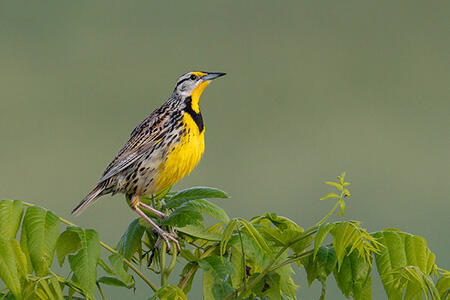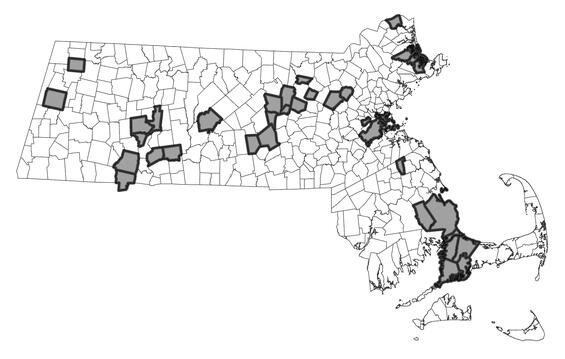- Scientific name: Sturnella magna
- Species of Greatest Conservation Need (MA State Wildlife Action Plan)
- Special Concern (MA Endangered Species Act)
Description

Eastern meadowlark
The eastern meadowlark is a stout, short-tailed songbird, 23-28 cm (9-11 in) long, with a black “V" on its yellow breast, streaked brown back, and white outer tail feathers. It is a bird of open grassland habitats, often perching on fenceposts where it sings its distinctive whistled song.
Life cycle and behavior
Eastern meadowlarks return to their breeding habitat in Massachusetts in late March, though a small number of birds often overwinter in the state. Pairs often return to the same breeding territories, and some males will pair with multiple females within a territory. Nesting occurs on the ground in large grasslands, and 1-2 broods of 4-5 eggs are laid per season. Eggs are incubated for about 14 days, and young leave the nest at around 11 days. Eastern meadowlarks primarily eat insects and seeds.
Population status
Eastern meadowlarks are thinly distributed across the state, and specific breeding sites have become increasingly scarce. Breeding Bird Survey data shows that the global population of eastern meadowlark has experienced an overall decline of 3.3% annually from 1966 to 2015. Northeastern states have seen the largest declines, with states such as Rhode Island (10.3%), Connecticut (12.6%) and Massachusetts (9.7%) seeing the sharpest declines during that timeframe. No state has recorded a significant population increase.
Distribution and abundance
Eastern meadowlarks breed throughout the eastern United States, Canada’s Maritime Provinces, the desert Southwest, and nearly continuously south to Panama. Individuals breeding in the northern limits of the range are short-distance migrants, often congregating in small flocks and moving south to areas free of snow.

Distribution in Massachusetts. 1999-2024. Based on records in the Natural Heritage Database.
Habitat
Eastern meadowlarks are most common in native grasslands, prairies, and savannah. They prefer moderately tall grasslands with abundant litter cover, a high proportion of grass, moderate to high forb density, and low coverage of woody vegetation. Various types of open habitats are utilized, such as tallgrass prairies, dry grasslands, cultural grasslands, hayfields, and airports. As with most grassland birds, breeding presence and the relevance of a site for eastern meadowlark are directly correlated to unfragmented patch size. Typically, eastern meadowlarks will not initiate breeding on grasslands of less than ten acres.
Healthy habitats are vital for supporting native wildlife and plants. Explore habitats and learn about conservation and restoration in Massachusetts.
Threats
The decline of eastern meadowlark populations in Massachusetts is attributed to loss of suitable nesting habitat due to landscape conversion (suburban sprawl, succession, and incompatible agricultural practices). Agriculturally, the main threat to breeding eastern meadowlarks in Massachusetts is the mowing of hayfields before the nesting cycle is complete. This results in near complete egg/nestling mortality, some adult mortality, and an overall decrease in species reproductive success. High winter mortality during especially severe winters is also a contributing factor in local declines.
An additional threat to the species is collisions with buildings and other structures, as approximately 1 billion birds in the United States are estimated to die annually from building collisions. A high percentage of these collisions occur during the migratory periods when birds fly long distances between their wintering and breeding grounds.
Predation by domestic cats has been identified as the largest source of mortality for wild birds in the United States with the number of estimated mortalities exceeding 2 billion annually. Cats are especially a threat to those species that nest on or near the ground.
Conservation
Land-use practices that provide suitable nesting habitat should be encouraged, particularly the development of incentives for ecologically sensitive agricultural practices that promote the increased acreage of hayfields and pastures that are in a delayed harvest (hayfields) or grazed on a rotation (pastures). In areas of more “industrialized” habitats, such as airports, efforts should be made to coordinate with site managers to reduce areas of grassland succession and to minimize mowing during the nesting season. Where suitable habitat currently exists, efforts should be made to protect the landscape from development.
Bird collision mortalities can be minimized by making glass more visible to birds. This includes using bird-safe glass in new construction and retrofitting existing glass (e.g., screens, window decals) to make it bird-friendly and reducing artificial lighting around buildings (e.g., Lights Out Programs, utilizing down shielding lights) that attract birds during their nocturnal migration.
Promote responsible pet ownership that supports wildlife and pet health by keeping cats indoors and encouraging others to follow guidelines found at fishwildlife.org.
References
Askins, R.R. Restoring North American Birds. New Haven, CT: Yale University, 2000.
Hull, S.D. Effects of Management Practices on Grassland Birds: eastern meadowlark. Revised 2002. Jamestown, ND: Northern Prairie Wildlife Research Center, 2000.
Jones, A.L., G. Shriver, and P. Vickery. Regional Inventory of Grassland Birds in New England and New York, 1997-2000. Lincoln, MA: Massachusetts Audubon Society, 2001.
Lanyon, W.E. “eastern meadowlark (Sturnella magna).” 1995. The Birds of North America, No. 160 (A. Poole and F. Gill, eds.). Philadelphia, PA: The Birds of North America, Inc.
Sauer, J.R., D.K. Niven, J.E. Hines, D.J. Ziolkowski, Jr., K.L. Pardieck, J.E. Fallon, and W.A. Link. The North American Breeding Bird Survey, Results and Analysis 1966 - 2015. Version 2.07.2017. Laurel, MD: USGS Patuxent Wildlife Research Center, 2017.
Veit, R., and W.R. Petersen. Birds of Massachusetts. Lincoln, MA: Massachusetts Audubon Society, 1993.
Walsh, J., and W. Petersen, eds. The Massachusetts Breeding Bird Atlas 2. New York, NY: Massachusetts Audubon Society and Scott & Nix, Inc., 2013.
Contact
| Date published: | April 4, 2025 |
|---|